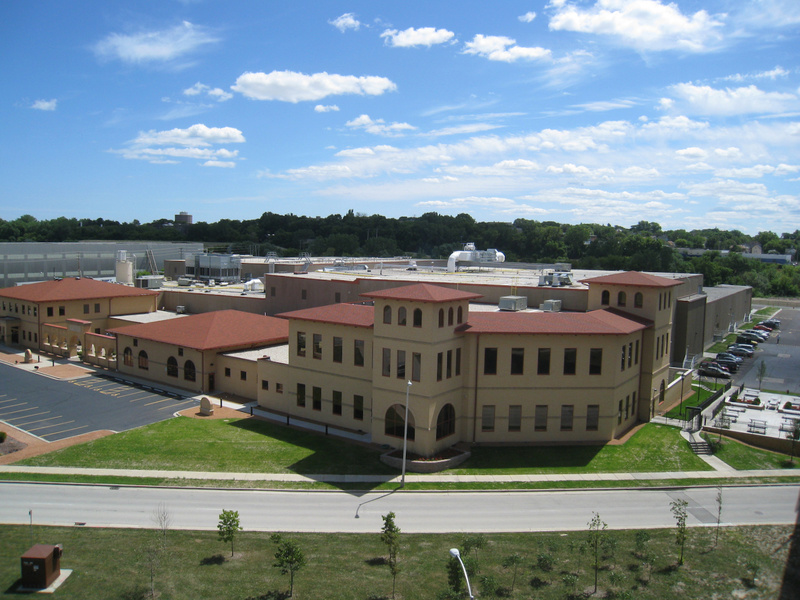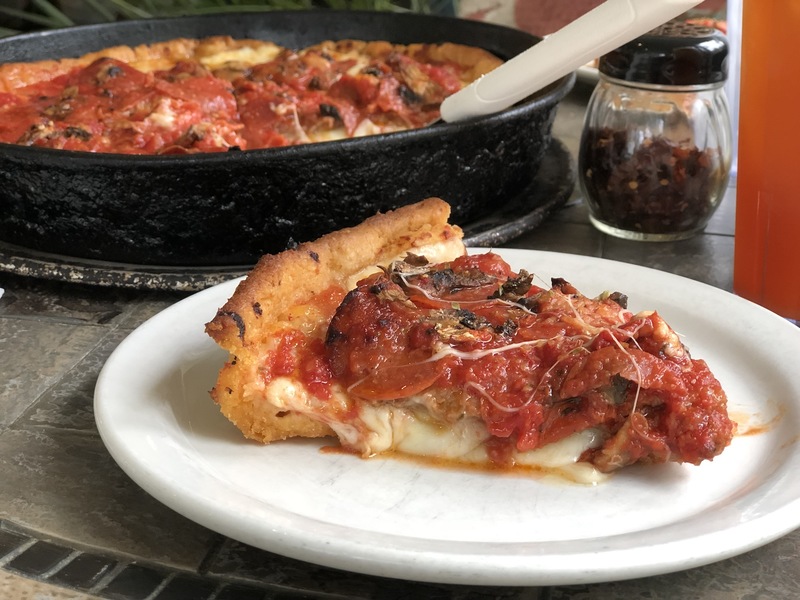I’m sure you’re familiar with Palermo’s frozen pizzas. But this blog is not about frozen pizzas. Some of you have taken the Palermo’s factory tour, learning the history of Palermo’s – going back to the bakery opened in 1964 by Gaspare and Zina Fallucca who came to Milwaukee in 1954 – and sampling the hand-stretched pan pizza that tour guests enjoy.
However, did you know that in January last year, the Fallucca family took their company to another level by updating the café at Pizzeria 3301, 3301 W. Canal St., and installing a wood-burning oven that was made in Italy using ashes from Mount Vesuvius? It’s true. Pretty cool, right?
Further, did you know that Palermo’s sent two executives – Executive Chef Arturo Napoles Carrera and a food scientist – to Washington last September to take a four-day class led by a representative of the Associazione Verace Pizza Napoletana (AVPN), who was flown in from Italy so they could become certified pizzaioli, aka pizza makers?
I hope that got your attention because I only know of one other person in southeastern Wisconsin with that distinguished designation, Transfer Pizzeria’s chef and co-owner Vasyl Lemberskyy. I don’t know about you, but I think it’s a big deal.
It is my understanding that, according to the AVPN, there are rules and regulations covering the manufacturing of the oven that can be used to bake the pizza, the wood used in the oven, the ingredients used in the pizza such as San Marzano tomatoes for the sauce, the technique used in making the pizza including temperature of the water and amount of salt to use for the pizza dough based on the weather, etc.
It's all to protect the integrity of the true Neapolitan pizza from the fast food chains and food manufacturers that improperly call their pizzas, fresh or frozen, "original Neapolitan pizzas."
There is also an official American delegation of the AVPN, allowed by the Italian government to be "a legal entity able to give special designation to pizzerias who meet strict requirements that respect the tradition of the art of Neapolitan pizza-making."
So, yes, I do think it is a pretty big deal to have an individual in Milwaukee be considered a certified pizzaiolo by an organization based in Italy, supported by the Italian government, to uphold the integrity and traditions of their treasured Neapolitan pizza and pizza masters.
That is why I write this blog. We have people missing out on some special pizzas, and I want to help show them the way to pizza happiness.
Pizza happiness can be found in the wood-fired pizzas of Pizzeria 3301 at Villa Palermo. They are baked in a brick oven that heats up to over 800 degrees, but is typically around 750 degrees, cooking the pizzas in as little as 90 seconds.
The wood-fired pizzas are all 11 inches and include a classic Margherita; prosciutto and arugula; mozzarella and pesto; fungi and salsiccia with Italian sausage, fresh mushrooms, and onions; Capricciosa with fresh mushrooms, ham, salami, artichokes and olives; and the Calabrese with a spicy soppressata salami, Calabrian chili paste and basil.
The Italian sausage is made in-house at Palermo’s using a family recipe that is over 60 years old, before Gaspare and Zina Fallucca immigrated to the United States. The pizza dough and sauce are also made from scratch with whole San Marzano tomatoes canned and imported from Italy.
Gluten-intolerant pizza lovers will find a gluten-free pizza on the menu with a crust that Palermo’s purchases from a distributor. The crust arrives frozen as a 9-inch disc and starts at $12, while the traditional wood-fired crusts start at $10.25.
If you are allergic to gluten, let the staff know so your pizza can be cooked in a separate oven. If you’re just avoiding gluten for lifestyle reasons, your gluten-free crust can be cooked in the wood-fired oven, but do not expect the gluten-free pizza to taste like the other traditionally cooked pizzas.
If you’re in the mood for a wood-fired dessert pizza, you’ll find pear and mascarpone on the menu for $19.75 and a s’mores pizza for $15.
Wood-fired pizzas are only available at Pizzeria 3301 between 10 a.m. and 2 p.m. Monday through Friday, but if you can’t make it over during that time, you have a couple of options. Pizzeria 3301 at Villa Palermo plans to stay open until 9 p.m. on Friday nights and until 3 p.m. on Saturday afternoons in summer.
If you prefer not to wait, the pizzeria also offers a monthly wine and pizza pairing, as well as a monthly beer and pizza pairing. The wines all come from Italy and change monthly. The beers come from local breweries and also change monthly.
Lakefront Brewery and Milwaukee Brewing Company were featured during the last two pairings. Pizzas for the beer pairings might include saltier pizzas such as mushroom and radicchio, or the Calabrese.
Guests can enjoy pairings of five different pizzas with five different wines or beers, as well as a condensed factory tour, for $30 per person. You can register for a scheduled pairing or schedule a private event.
Perhaps you’d like to learn to make pizzas. Chef Arturo offers pizza-making lessons too. There are details at palermospizza.com, or email events@palermospizza.com to set up a private event for your group.
I scheduled a private wine and pizza pairing event on a Thursday night last month for a group of 28 guests, and we had a great experience.
Our five pizzas included the roasted vegetables and goat cheese; prosciutto and arugula; Margherita; fungi and salsiccia, which is the sausage, mushroom and onion pizza that I’ve found to be a popular combination in Milwaukee; and a s’mores pizza with chocolate chips, marshmallows and crushed graham crackers for the dessert round – based on an idea he received from his 7-year-old daughter.
The crust was perfectly crisp yet soft like a pillow around the edges, which also had the slightly charred look that I like. Two of the pizzas used olive oil instead of tomato sauce, and I didn’t miss the sauce at all.
The roasted vegetable and goat cheese pizza was topped with a drizzle of balsamic vinegar and paired well with the pinot grigio. The prosciutto on the second pizza, which was paired with a Montepulciano wine, is imported from Italy and had a perfectly salty taste to it to balance the bitterness of the arugula. It was also garnished with a balsamic drizzle.
The margherita, paired with a Salice Salentino wine, probably represents a true Neapolitan pizza due to its simplicity, topped with fresh made tomato sauce that carried the flavor of the fresh basil in it, fresh buffalo mozzarella and basil leaves.
For dessert, we expected the pear and mascarpone, but were pleasantly surprised when Chef Arturo presented us with the s’mores pizza.
I watched him apply some fresh mozzarella and chocolate chips, and put the pizza in the oven for a few seconds. Then he pulled it back out, crumbled graham crackers over the center and applied a layer of mini-marshmallows before putting it back in the oven to finish. He sprinkled powdered sugar over the pie before finally serving it.
Paired with a malvasia wine, my group got a huge kick out of the s’mores pizza, and it became the favorite pizza of the night for many. I think the Margherita may have been my favorite, which is surprising considering I’m a serious carnivore.
Aside from the wood-fired artisan pizzas, Pizzeria 3301’s menu also includes soup, salad, sandwiches, hand-stretched pan-style pizza by the slice and 12-inch whole hand-tossed pizzas.
Only the artisan pizzas are baked in the wood-fired oven. The three different pizza crust styles provide three different pizza tastes so diners can stay in their comfort zone or simply have an option for pizza outside of the 10-to-2 wood-fired oven window of operation.
Chef Arturo wants to show Milwaukee how beautiful pizza can be and illustrate how you can put almost anything on a pizza and "not mess it up."
"Food is connected to memories and we want to create new memories for you," Chef Arturo said.
Well said, chef. I happen to know 28 people who’ll confirm that mission was accomplished.
I graduated from Rufus King High School and the University of Wisconsin-Whitewater with a business degree.
My true passion for Milwaukee probably started after I joined the Young Professionals of Milwaukee (now called FUEL Milwaukee) which just celebrated its one year anniversary at the time. The events that I attended, and sometimes organized, really opened my eyes to what Milwaukee had to offer, as well as its potential for the future. So for the past, present, and future FUEL Milwaukee corporate sponsors out there, that organization does produce results (editorial)!
I love all of the Milwaukee Sports teams, professional and amateur. I love the Milwaukee arts scene and all of the festivals. I love that you can find a free concert in the summer just about every day of the week. I love the various neighborhoods around the Milwaukee area and the unique characteristics that they offer. I love the people who take the time to tell us about those unique characteristics. I have to hold my breath and count to ten when someone tells me that there is nothing to do in Milwaukee. Then I prove them wrong.
Most of all, I love the Milwaukee dining scene. I love how it continues to evolve with modern dishes and new trends while the classic restaurants continue to remind us that great food doesn't have to be "fancy schmancy." However, I also love the chefs that create the "fancy schmancy" dishes and continue to challenge themselves and Milwaukee diners with dishes we've never seen before.
Our media provides attention to the new restaurants, which is great, but I don't like seeing the older great restaurants close their doors (Don Quijote, African Hut) because they've been forgotten, so I try to do my part to let Milwaukeeans know that they're still out there, too. I do that through social media, online reviews, and a dinner club I run for my friends, where we visit restaurants they haven't heard of before or try ethnic cuisine they haven't had before.
My dream is that one day I can mention a great experience in Milwaukee and not have someone respond with "have you been to Chicago?" I don't like those people very much.







